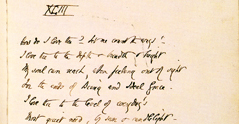COLONIAL DISCOURSES
Series One: Women, Travel & Empire, 1660-1914
Part 2: Women and the Orient
'The Orient is not only adjacent to Europe, it is also the place of Europe's greatest and richest and oldest colonies, the source of its civilisations and languages, its cultural contestant, and one of it deepest and most recurring images of the Other. In addition, the Orient has helped to define Europe (or the West) as its contrasting image, idea, personality, experience.'
Edward W Said writing in Orientalism: Western Conceptions of the Orient
Parts 2 and 3 of Series One address the theme of Women and 'The Orient' and record women traveller's impressions of harem culture, life in the Middle East, and exotic experiences in China and Japan. They show clearly that there is not one 'orientalist' view but a whole range of overlapping views that need to be carefully examined. For instance:
- How did women's views conflict with those of their male counterparts who were often imperial agents?
- How did women view local customs?
- Was the veil a liberating device?
- Were harems dens of iniquity or places of refuge?
- How real was the white slave trade?
- How did local cultures react to women travelling alone and asserting authority?
All of these questions can be investigated using the sources provided here which will show how the image of the Orient was constructed and challenged.
The range of material included is diverse. Sample titles include:
- Mrs Belzoni's Account of Women in Egypt, Nubia and Syria (1820) by Sarah Belzoni
- The Inner Life of Syria, Palestine and the Holy Land (1897) by Isabel Burton
- Chow Chow: Being selections from a journal kept in India, Egypt and Syria (1857) by Amelia Cary
- Wanderings in China (1886) by Constance Cumming
- Behind the Veil in Persia and Turkish Arabia: an Account of an Englishwoman's Eight Years Residence - - Amongst the Women of the East (1909) by M E Hume-Griffith
- Actual Life in a Turkish Harem by Vahan Cardashian (1911)
- Things seen in Egypt by Edith by Louisa Butcher (1910)
- Narrative of a Journey from Calcutta to Europe, by way of Egypt in the years 1827 and 1828 (1829) by Sarah Lusington
- Girl-Life in the Harem: A true account of Girl-Life in Oriental climes (1908) by Annie Reichardt
The writers include archaeologists, explorers, missionaries, novelists and tourists. Some are written while travelling in the company of their fathers or husbands. Others are written by women who chose to travel alone. Some explore the now familiar sites of antiquity that had been popularised by Egyptologists in the Napoleonic period. Others explore sociological and ethnographic themes. Two male writers are included by way of comparison. Pierre Loti's Les trois dames de la Kasbah (1896) and Madame Chrysantheme (1889) created powerful characterisations that have frequently been copied, while Griffin Vyses's An Englishman in a Harem (1887) can be profitably compared with titles such as Emmeline Lott's Nights in the Harem (1867).
All those exploring the Literature of Empire, cultural contacts and the 'other' in fact and fiction will welcome these sources.
|















